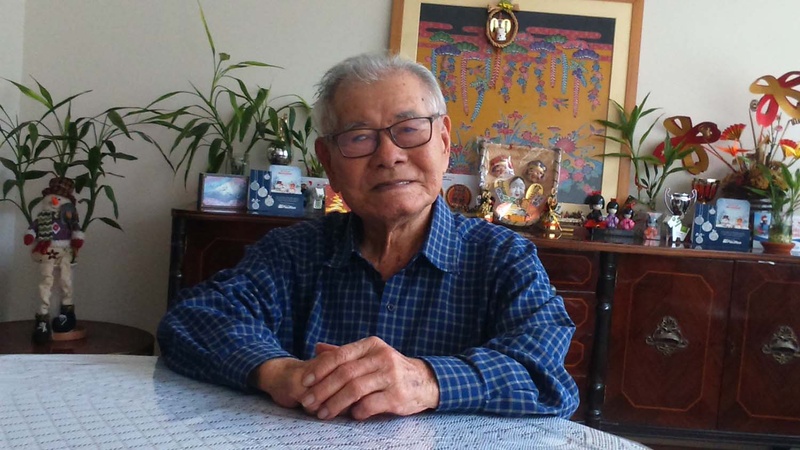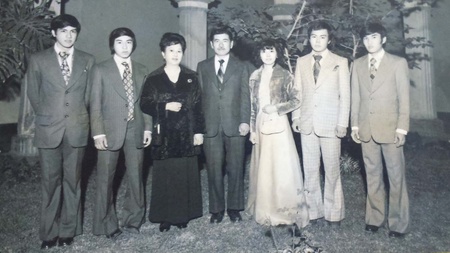After greeting Kisey Higa, I tell him that my last name is like him, that my family was from Callao and that I am the nephew of Mitsuya, the bullfighter. “You are Renzo San's grandson, right?” he says.
I expected him to say something like “oh yeah, I know your uncle,” and nothing more, so I'm surprised he even remembers my grandfather's name. Later, during the interview, while we talk about World War II, I tell him that I had a great-uncle who was deported to the United States, and he surprises me again when he remembers his name and what he did (Rensuke, he produced chicha).
One day before I was going to interview him, a Nikkei girl who will travel to Japan for a scholarship visited Don Kisey to learn a little more about his family history. It turned out that he knew his grandparents from both branches.
Kisey Higa seems to know everyone in the Nikkei community. Telling him that you are the son, nephew, grandson or brother of this or that person is like Googling your name, because he answers you immediately.
That is also surprising. He doesn't hesitate. It doesn't say “you are the son of... what was his name?” Oh yes, it was called... It is fast and forceful, like someone pulling the trigger: names and data come out like bullets. Throughout the extensive conversation that we had only a couple of times he could not remember some names.
Share your memories in strict chronological order. No fact is left to chance. It contextualizes everything it tells. Who, when chatting with an older person, has not had to shortcut and channel their memories, which spread in all directions?
With Kisey Higa it is not necessary. He has everything organized in his head: in 1917, his Okinawan parents emigrated to Peru (just one hundred years ago, he highlights); In 1919, his older sister Haruko was born; in 1923, he was born in Chancay; In 1925, his father lost his entire harvest on the San Agustín hacienda and the entire family moved to the city of Callao; In 1928, the Japanese school where he studied primary school was founded; and in 1933, the Higa family returned to San Agustín, where they put down roots.
NOSTALGIA AND DREAMS
The interview begins before I can ask you the first question. I'm barely turning on the recorder when Don Kisey is already telling me that the war changed the plans of the Japanese immigrants: their original intention was to make money in Peru and return to their country; meanwhile, they sent their children to Japanese schools. After the war, they decided to anchor permanently in Peru.
His father arrived in Peru to work on the Santa Bárbara ranch, Cañete. Except for a brief stint in commerce, with a store in Callao, he dedicated his life in Peru to agriculture. Kisey last saw him in 1941, when he traveled to Japan to attend his father's 88th birthday. He could not return to Peru because of the war. The situation worsened after the attack on Pearl Harbor and the entry of the United States into the armed conflict.
Kisey's father died on Okinawa during the war; his mother, in 1947. Dire circumstances that pushed him to look after his four younger siblings (the eldest, Haruko, died at a young age). The youngest of his brothers refers to him as “my dad.”
The war did not cause as much havoc on the San Agustín hacienda as in other parts. Only one Issei was deported to the United States and there was no looting like in Lima 1 , just a skirmish: a group of young people tried to assault a Japanese man, but he scared them away by firing his firearm into the air. One of the owners of the hacienda was the then president of Peru, Manuel Prado.
Don Kisey lived for almost eighty years in St. Augustine, the homeland of many Japanese immigrants and their descendants.
“All my life I have dedicated myself to agriculture, I always remember that time with nostalgia. I grew a lot of flowers... vegetables. “Sometimes I dream (of Saint Augustine),” he says melancholy.
For much of his life he grew cotton. Like all the farmers on the estate, he did not pay the owner with money, but with part of his harvest. He also grew cauliflower, tomatoes, and onions, among other staple products, and even had a guinea pig farm.
The school where he studied was only recognized by the Peruvian Ministry of Education in 1938. As if remembering a prank, he smiles when he says that although he had already finished his studies, he decided to continue attending school in 1938 so that his education would have value. official in Peru.
Teaching was exclusively in the Japanese language until third grade. From then on, bilingual.
Don Kisey fondly remembers the Japanese teachers he had. He was able to meet several again in 1976 and 1990, when he traveled to Japan. He dedicates a detailed account to the second trip, the one in 1990, because thanks to a promotion, at a bargain price, he was able to travel with his wife from one end to the other, from Hokkaido to Kagoshima, on a train. Like a boy reminiscing about his school promotion trip, he excitedly recounts that he crossed the underwater tunnel that connects the islands of Honshu and Hokkaido. Paying attention to the numbers as always, he details the extent of the tunnel and how deep it is.
“BETTER THAN ALL OF US”
Kisey Higa's passion for history is known. I ask him what part of history he likes the most and he answers everything: Okinawa, Japan, Peru, Japanese immigration. Plus, he's a news fanatic. “His vice is watching channel N 2 ,” says his daughter Mery.
She remembers that when she was little, her father was regularly visited by people from the Nikkei community to translate documents, write letters, or for advice.
As part of his career, he can also showcase his leadership work: he has been president of the Peruvian-Japanese Association of Callao and the Okinawan Association of Peru (during his administration the Olympic swimming pool was inaugurated). In 1993 he was decorated by the government of Japan.
Don Kisey and his wife Kiyoko had six children. The oldest died. Mery highlights that thanks to the efforts of both of them, all of their children were able to study at university. Like everyone, she is also impressed by her dad's incredible memory. “Better than all of us,” he says.
Mery also shares memories. One of his uncles once told him that during the war, when everything Japanese was stigmatized, Nisei children studied in secret: they buried their books in the dirt of the farm and rotated from house to house to attend classes.
Don Kisey listens patiently when not intervening. He does not seek prominence. Although the conversation lasts much longer than expected, at no time does he make any gestures of annoyance or concern. He may be tired, but he doesn't show it. It seems like he never bothers. There is a kind of Zen calm in his patience and serenity, as if he had reached heights inaccessible to those of us who still have much to learn.
How much does a sense of humor influence a person's longevity? I don't know, but I suspect not a little. At least in Don Kisey's case it seems to work. Since he has difficulty walking, he gets around with a walker. “My tire is flat,” he laughs.
EPILOGUE
I arrived at Kisey Higa's house imagining that he would know some things about my paternal family, but I never thought I would find a distant relationship on the other side. Talking with her daughter Mery, I find out that her mother is the first cousin of the grandmother of a first cousin I have on my mother's side. It may sound a bit confusing, but this kind of coincidence makes you think about how small the world is sometimes, especially among the Nikkei, where everyone seems to be interconnected in one way or another.
This coincidence made me think about how unexpected bridges are established. I remember several years ago I went to interview an Issei. With her was her daughter, who did not seem happy that I was there, as if it were an inopportune visit that, shoganai , must be endured. However, at one point in the interview I mentioned my paternal grandmother, who it turned out had been a very good friend of her mother. As if my obaachan's name was a magic wand, the lady's attitude changed a lot. He was very kind, bought me lunch and made me feel like a nephew I hadn't seen in a long time.
Grades:
1. On May 13, 1940, mobs looted Japanese businesses and homes in Lima.
2. Well-known news channel in Peru.
© 2017 Enrique Higa








